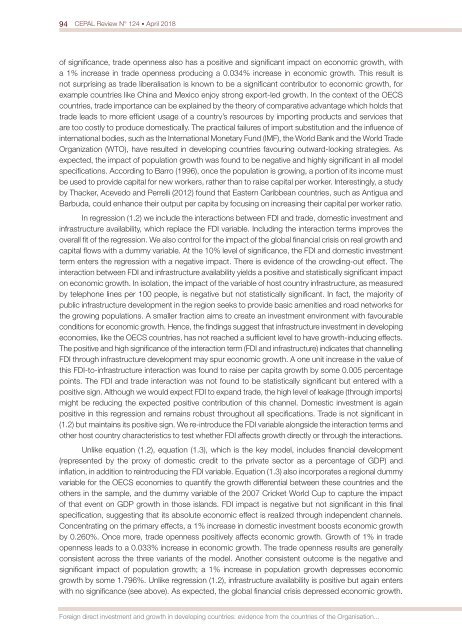CEPAL Review no. 124
April 2018
April 2018
You also want an ePaper? Increase the reach of your titles
YUMPU automatically turns print PDFs into web optimized ePapers that Google loves.
94 <strong>CEPAL</strong> <strong>Review</strong> N° <strong>124</strong> • April 2018<br />
of significance, trade openness also has a positive and significant impact on eco<strong>no</strong>mic growth, with<br />
a 1% increase in trade openness producing a 0.034% increase in eco<strong>no</strong>mic growth. This result is<br />
<strong>no</strong>t surprising as trade liberalisation is k<strong>no</strong>wn to be a significant contributor to eco<strong>no</strong>mic growth, for<br />
example countries like China and Mexico enjoy strong export-led growth. In the context of the OECS<br />
countries, trade importance can be explained by the theory of comparative advantage which holds that<br />
trade leads to more efficient usage of a country’s resources by importing products and services that<br />
are too costly to produce domestically. The practical failures of import substitution and the influence of<br />
international bodies, such as the International Monetary Fund (IMF), the World Bank and the World Trade<br />
Organization (WTO), have resulted in developing countries favouring outward-looking strategies. As<br />
expected, the impact of population growth was found to be negative and highly significant in all model<br />
specifications. According to Barro (1996), once the population is growing, a portion of its income must<br />
be used to provide capital for new workers, rather than to raise capital per worker. Interestingly, a study<br />
by Thacker, Acevedo and Perrelli (2012) found that Eastern Caribbean countries, such as Antigua and<br />
Barbuda, could enhance their output per capita by focusing on increasing their capital per worker ratio.<br />
In regression (1.2) we include the interactions between FDI and trade, domestic investment and<br />
infrastructure availability, which replace the FDI variable. Including the interaction terms improves the<br />
overall fit of the regression. We also control for the impact of the global financial crisis on real growth and<br />
capital flows with a dummy variable. At the 10% level of significance, the FDI and domestic investment<br />
term enters the regression with a negative impact. There is evidence of the crowding-out effect. The<br />
interaction between FDI and infrastructure availability yields a positive and statistically significant impact<br />
on eco<strong>no</strong>mic growth. In isolation, the impact of the variable of host country infrastructure, as measured<br />
by telephone lines per 100 people, is negative but <strong>no</strong>t statistically significant. In fact, the majority of<br />
public infrastructure development in the region seeks to provide basic amenities and road networks for<br />
the growing populations. A smaller fraction aims to create an investment environment with favourable<br />
conditions for eco<strong>no</strong>mic growth. Hence, the findings suggest that infrastructure investment in developing<br />
eco<strong>no</strong>mies, like the OECS countries, has <strong>no</strong>t reached a sufficient level to have growth-inducing effects.<br />
The positive and high significance of the interaction term (FDI and infrastructure) indicates that channelling<br />
FDI through infrastructure development may spur eco<strong>no</strong>mic growth. A one unit increase in the value of<br />
this FDI-to-infrastructure interaction was found to raise per capita growth by some 0.005 percentage<br />
points. The FDI and trade interaction was <strong>no</strong>t found to be statistically significant but entered with a<br />
positive sign. Although we would expect FDI to expand trade, the high level of leakage (through imports)<br />
might be reducing the expected positive contribution of this channel. Domestic investment is again<br />
positive in this regression and remains robust throughout all specifications. Trade is <strong>no</strong>t significant in<br />
(1.2) but maintains its positive sign. We re-introduce the FDI variable alongside the interaction terms and<br />
other host country characteristics to test whether FDI affects growth directly or through the interactions.<br />
Unlike equation (1.2), equation (1.3), which is the key model, includes financial development<br />
(represented by the proxy of domestic credit to the private sector as a percentage of GDP) and<br />
inflation, in addition to reintroducing the FDI variable. Equation (1.3) also incorporates a regional dummy<br />
variable for the OECS eco<strong>no</strong>mies to quantify the growth differential between these countries and the<br />
others in the sample, and the dummy variable of the 2007 Cricket World Cup to capture the impact<br />
of that event on GDP growth in those islands. FDI impact is negative but <strong>no</strong>t significant in this final<br />
specification, suggesting that its absolute eco<strong>no</strong>mic effect is realized through independent channels.<br />
Concentrating on the primary effects, a 1% increase in domestic investment boosts eco<strong>no</strong>mic growth<br />
by 0.260%. Once more, trade openness positively affects eco<strong>no</strong>mic growth. Growth of 1% in trade<br />
openness leads to a 0.033% increase in eco<strong>no</strong>mic growth. The trade openness results are generally<br />
consistent across the three variants of the model. A<strong>no</strong>ther consistent outcome is the negative and<br />
significant impact of population growth; a 1% increase in population growth depresses eco<strong>no</strong>mic<br />
growth by some 1.796%. Unlike regression (1.2), infrastructure availability is positive but again enters<br />
with <strong>no</strong> significance (see above). As expected, the global financial crisis depressed eco<strong>no</strong>mic growth.<br />
Foreign direct investment and growth in developing countries: evidence from the countries of the Organisation...


















